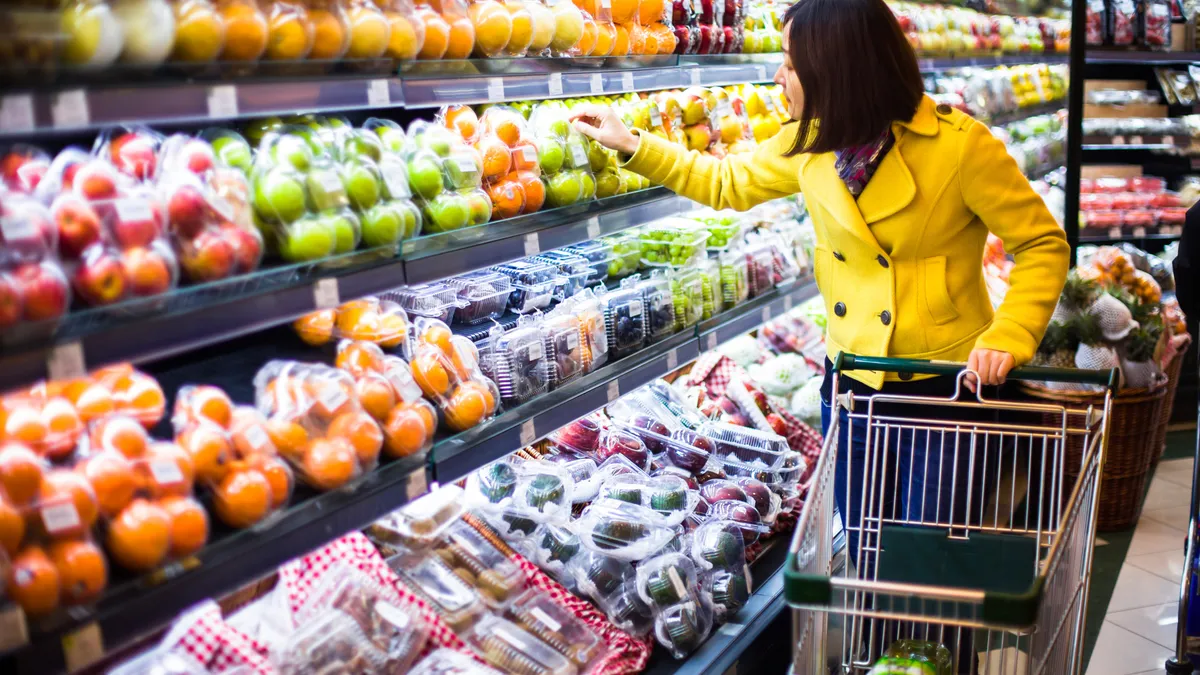Dive Brief:
- In IRI's Consumer Connect Q4 2017 survey, 28% of shoppers said they buy grocery items online compared with 23 percent in the first quarter of 2016.
- Survey participants said online grocery shopping reduces impulse buys, and 51% said they make fewer unplanned purchases online. One-fifth of consumers said it's easier to find items on their shopping lists online than at a store. To save on shipping fees, two-fifths of consumers surveyed said they like to order online and pick up in store.
- Respondents also said that shopping online offers easier access to discounts and allows them to compare prices between retailers. Over the course of the year, 55% of shoppers surveyed will download coupons from retailer or manufacturer websites.
Dive Insight:
Almost three decades ago, online grocery shopping and delivery launched under the premise that consumers would want to use the service to save time. But as consumers continue to struggle to pay for food and other essentials, it seems e-grocers will also have to convey value to win online shoppers. According to IRI, 31% of consumers in Q4 2017 said they are struggling to buy needed groceries compared with 30% in Q4 2016.
As food retailers ramp up efforts to focus on e-commerce, price has become a focus. In spring 2017, Walmart began offering discounts to online shoppers who pick up their groceries in store. When it bought Whole Foods last fall, Amazon pledged to lower prices. Now upstarts are experimenting with new value-driven models in which they focus on offering the most popular grocery items at prices lower than what consumers might see in a grocery store. At Brandless, for instance, non-branded food items sell for $3 each. The everyday price of a ten-ounce jar of organic coconut oil sells for about half the price at a grocery store.
These new models will force legacy food companies to build savings into their e-commerce strategy as they battle for the online grocery shopper, an industry that’s expected to reach $100 billion in sales and comprise 20% of the grocery space by 2025.
This reality may present a dilemma for food retailers who traditionally have relied on weekly specials to bring consumers into the store with the hope that shoppers fill their carts with other things while walking the aisles. Online fulfillment is expensive and unprofitable for most grocers right now, making discounts difficult to build in. But e-commerce's growth prospects, not to mention Amazon's potential to transform the industry, mean grocers need to — and have — establish programs.
If food retailers take a close look at the IRI research, they should focus on this finding: Consumers say online shopping saves money by providing access to coupons. Instead of intense price cutting, retailers may satisfy consumers need to find value simply by making it easier for them to access digital manufacturers coupons. They might also find an edge by promoting their own private label brands on most frequently purchased items as alternatives to more expensive national brands.
The research also notes that about half of consumers will go online to compare prices on needed items, so software applications that make it easier for a food retailer to showcase its prices on basic staples may also help it gain repeat orders.
In addition to offering weekly specials online, legacy grocers might also enlist in predictive analysis software toward personalizing deals for consumers based upon their past shopping habits.
At this point, there's no clear formula for success. Retailers will have to experiment to see what works best for their store's bottom line. “When consumers think about online CPG shopping, they have specific ideas about what is helpful in their lives,” Susan Viamari, vice president of thought leadership for IRI said in a statement. “There really is no one-size-fits-all answer, so it’s critical to understand what it is that makes your key shoppers tick.”








